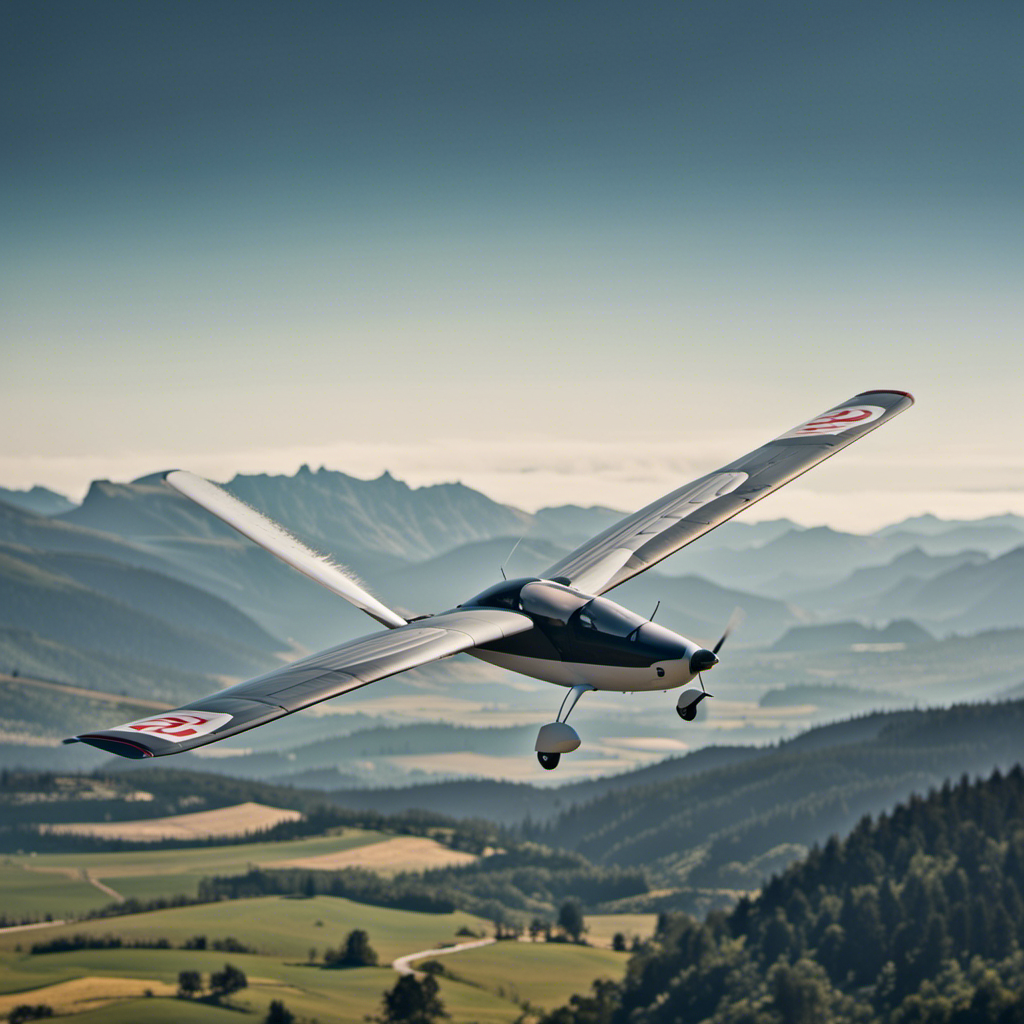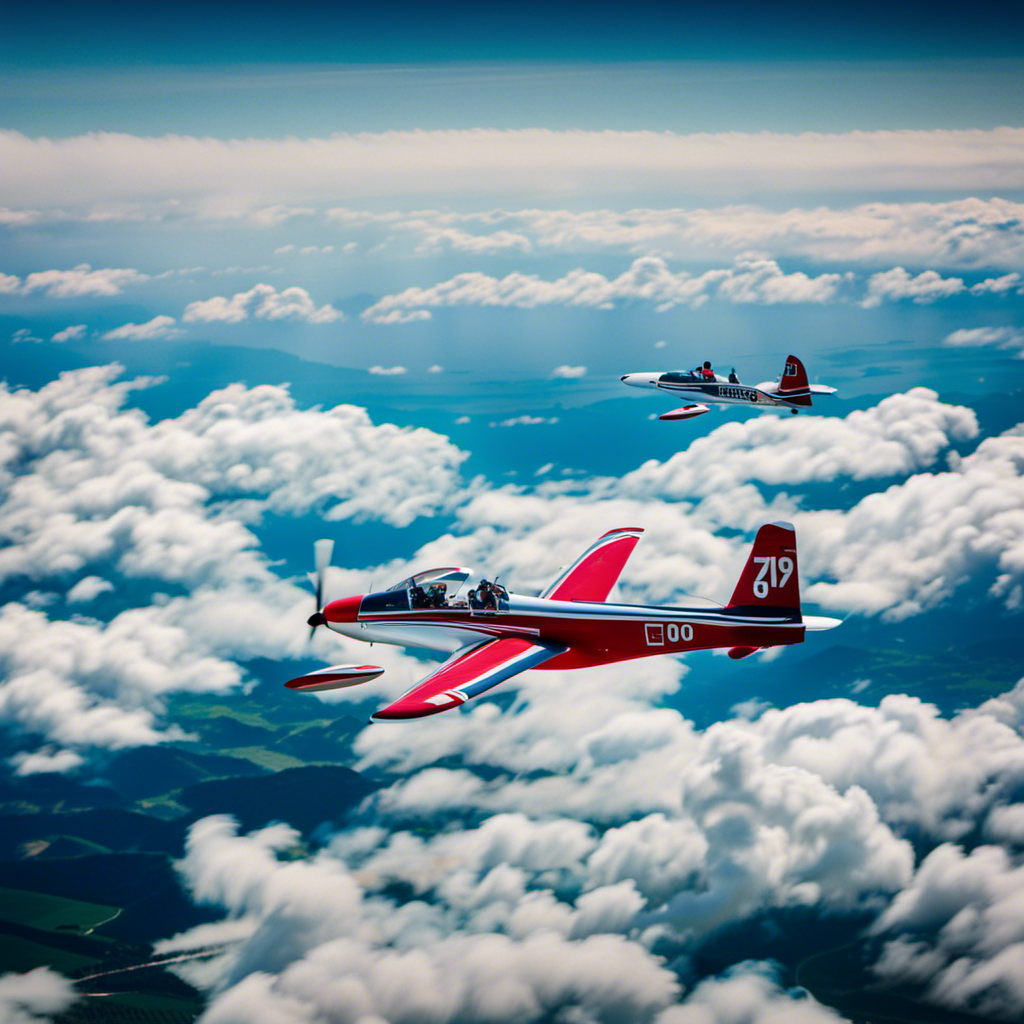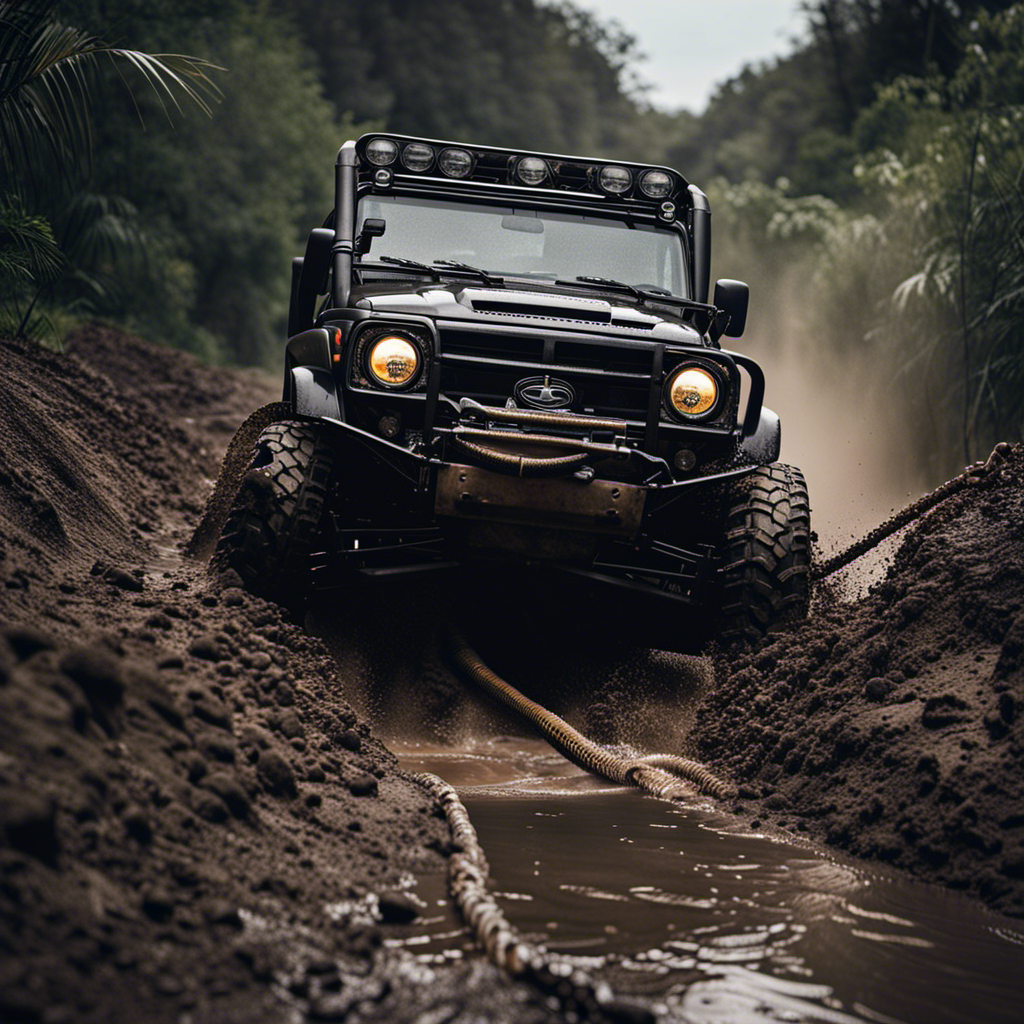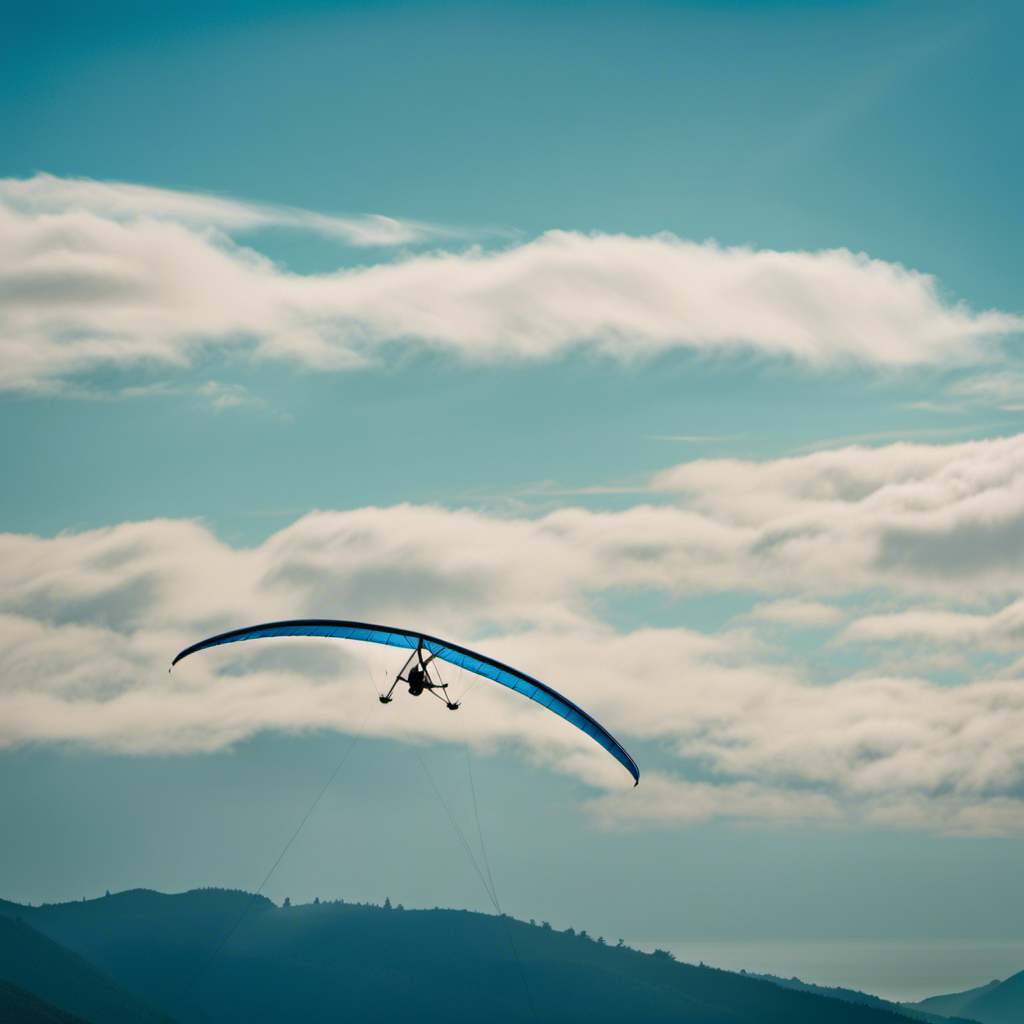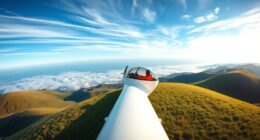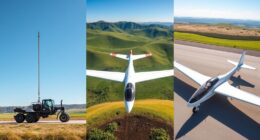Here I am, strapped into a glider, about to embark on my first flight. It’s funny to think about how just a few weeks ago, I knew nothing about gliding. But now, I’m ready to take flight with knowledge and a sense of adventure.
In this article, I’ll walk you through the basics of glider flying, from preparing for your first flight to eventually flying solo. Get ready to soar.
Key Takeaways
- Safety procedures and emergency protocols are crucial in glider flying.
- Knowledge of weather patterns and conditions is essential for safe flying.
- Proper preparation and pre-flight checks are necessary before each flight.
- Mastering takeoff and landing techniques, including assessing wind conditions, is important for successful glider flights.
Introduction to Glider Flying
Before you can take to the skies solo, it’s important to have a solid introduction to glider flying. Glider safety and flying in different weather conditions are two key aspects of this introduction.
Let’s start with glider safety. As a glider pilot, it is crucial to understand the safety procedures and protocols to ensure a safe flying experience. This includes conducting pre-flight inspections, understanding emergency procedures, and having a thorough understanding of the glider’s limitations and capabilities. Additionally, being aware of airspace regulations and practicing good communication skills with other pilots is essential for safe flying.
Flying in different weather conditions is another important aspect of glider flying. Weather plays a significant role in determining the feasibility and safety of a flight. As a glider pilot, it is crucial to have knowledge of weather patterns, including wind direction and speed, cloud formations, and temperature changes. Understanding how these factors can impact the glider’s performance and flight characteristics is vital for making informed decisions. It is also essential to have the ability to interpret weather forecasts and make judgments about the suitability of flying conditions.
Now that you have a solid introduction to glider flying, let’s move on to preparing for your first flight.
Preparing for Your First Flight
As a pilot preparing for my first flight, it’s crucial for me to understand the flight plan, learn pre-flight checks, and get acquainted with the cockpit.
Understanding the flight plan involves studying the route, airspace restrictions, and weather conditions.
Learning pre-flight checks ensures that the glider is in optimal condition for flight, including checking the control surfaces, instruments, and fuel levels.
Getting acquainted with the cockpit involves familiarizing myself with the location and function of the various controls, switches, and instruments necessary for safe and efficient flight.
Understanding the Flight Plan
Understanding the flight plan is crucial for a glider pilot. It ensures a safe and efficient flight, taking into account various factors such as weather conditions and flight dynamics. Here are some key points to consider:
-
Flight Dynamics: By studying the principles of aerodynamics, I can better understand how the glider behaves in different situations. This knowledge allows me to make informed decisions during the flight.
-
Evaluating Weather Conditions: Assessing the weather conditions is essential for a successful flight. Factors like wind speed, cloud cover, and temperature influence the glider’s performance and safety.
-
Navigation: Following a well-defined flight plan helps me navigate through the airspace and reach my destination accurately. It includes waypoints, altitude restrictions, and emergency landing options.
-
Contingency Planning: Being prepared for unexpected situations like changes in weather or equipment malfunctions is crucial. I always have a contingency plan in place to ensure a safe outcome.
Understanding the flight plan sets the foundation for the next step: learning pre-flight checks. By meticulously inspecting the glider before each flight, I can ensure that it is in optimal condition for takeoff and mitigate any potential risks.
Learning Pre-Flight Checks
Make sure to thoroughly inspect the aircraft before each flight to ensure its safety and optimal condition. Learning glider controls and understanding aerodynamics are crucial elements of becoming a skilled glider pilot.
Before even getting into the cockpit, it is essential to familiarize yourself with the aircraft’s exterior. Check for any signs of damage, such as dents or cracks, and ensure that all control surfaces are intact and functioning properly. Pay close attention to the wings, tail, and fuselage, as they play a vital role in the glider’s stability and maneuverability.
Understanding the aerodynamic principles at play will help you appreciate how the glider responds to different inputs and air conditions. By thoroughly inspecting the aircraft, you are laying the foundation for a safe and successful flight.
Now that we have ensured the glider’s condition, let’s move on to getting acquainted with the cockpit.
Getting Acquainted with the Cockpit
Take a moment to familiarize yourself with the cockpit, as it is where you’ll control and navigate the glider during your flights.
The cockpit layout is designed to maximize efficiency and provide easy access to essential controls and instruments.
The primary instrument panel is located in front of you, displaying crucial information such as airspeed, altitude, and variometer readings.
To your left, you’ll find the control stick, responsible for maneuvering the glider in pitch and roll.
On the right, the cockpit instruments include the radio, GPS, and other navigation aids.
It’s crucial to understand the function and operation of each instrument before taking off.
Now that you’re acquainted with the cockpit, let’s move on to the next section: taking off and landing, where we’ll explore the procedures involved in these critical phases of flight.
Taking Off and Landing
When it comes to taking off and landing in a glider, mastering the takeoff procedure is crucial for a successful flight. Understanding the steps involved, such as proper wing alignment and use of controls, is essential to ensure a smooth and safe departure from the ground.
Once airborne, techniques for smooth landings become paramount, focusing on factors like approach angle, airspeed control, and flare technique.
Additionally, dealing with crosswinds presents a unique challenge, requiring the pilot to employ techniques like crabbing and side-slipping to maintain control and ensure a stable landing.
Mastering the Takeoff Procedure
To ensure a successful takeoff, you’ve got to remember to check the wind direction and speed. Mastering takeoff techniques is essential for improving takeoff efficiency.
The first step is to assess the wind direction and speed by observing the movement of nearby trees or using a windsock. Once determined, position the glider to align with the wind, ensuring a headwind or crosswind takeoff.
Next, apply full control input to maintain a straight course during the takeoff roll. As the glider gains speed, smoothly and progressively apply backpressure on the control stick to lift the nosewheel off the ground.
Techniques for Smooth Landings
One important technique for smooth landings is maintaining a proper glide slope throughout the approach. This involves controlling the rate of descent and ensuring a steady descent angle. To achieve this, pilots must employ various landing techniques and have precise touchdown control.
Here are five key factors to consider for smooth landings:
- Flare technique: Gradually raising the nose just before touchdown to reduce the descent rate and achieve a gentle touchdown.
- Speed control: Maintaining the appropriate airspeed during the approach to ensure a smooth transition from descent to landing.
- Alignment: Ensuring the glider is aligned with the runway centerline for a straight touchdown.
- Wind correction: Adjusting the approach angle and rudder inputs to compensate for crosswinds and maintain a centered landing.
- Braking technique: Applying brakes smoothly and progressively after touchdown to bring the glider to a stop without jerking or bouncing.
By mastering these landing techniques and practicing precise touchdown control, pilots can achieve smooth landings and improve overall flight safety.
Transitioning into the subsequent section about ‘dealing with crosswinds,’ pilots must also be prepared to handle challenging wind conditions during landing.
Dealing with Crosswinds
Dealing with crosswinds can be challenging, but I’ve learned to mitigate their effects through proper techniques and adjustments.
One important strategy for crosswind landings is establishing a crab angle during final approach. This means aligning the aircraft’s nose with the runway centerline while keeping the wings level.
As I transition from the approach to the flare, I smoothly apply opposite rudder to align the aircraft with the runway direction. Additionally, I use aileron inputs to offset the wind’s effect on the wings.
By mastering these crosswind flight strategies, I’m able to maintain control and ensure a safe landing even in challenging conditions.
Now, let’s move on to the next section about basic flight maneuvers.
Basic Flight Maneuvers
Flying a glider involves mastering basic flight maneuvers, such as turns and climbs. These maneuvers are essential for a safe and controlled flight, especially when faced with unexpected situations. Here are three key basic flight maneuvers that every glider pilot must learn:
-
Banked turns: Executing smooth and coordinated turns is crucial for maintaining control and stability during flight. By properly banking the glider, you can maintain a constant altitude and change direction smoothly while minimizing the risk of stalling.
-
Climbing and descending: Understanding how to climb and descend efficiently is essential for gaining or losing altitude. By adjusting the glider’s pitch and airspeed, you can control the rate of climb or descent, ensuring a safe and controlled maneuver.
-
Stall recovery: In the event of a stall, it is vital to know the appropriate recovery techniques. By promptly applying corrective actions, such as reducing the angle of attack and applying power, you can regain lift and prevent a potential spin.
Mastering these maneuvers not only enhances flight safety but also prepares pilots for emergency procedures.
Transitioning from basic flight maneuvers, the next section will delve into the intricacies of navigation and cross-country flying, expanding our understanding of glider aviation.
Navigation and Cross-Country Flying
Navigating and flying cross-country in a glider requires careful planning and a solid understanding of navigation techniques. As a glider pilot, I’ve learned the importance of properly plotting my course and utilizing thermal soaring to maximize my distance. Let me share with you some key navigation techniques that have helped me successfully navigate through the skies.
One crucial aspect of cross-country flying is identifying and utilizing thermal updrafts. These rising columns of warm air provide the glider with extra lift, enabling us to stay airborne for longer periods. By carefully observing cloud formations, ground features, and the behavior of other gliders, we can locate thermals and use them to our advantage.
To visually demonstrate the importance of navigation techniques, I’ve created a table showcasing some key methods and their benefits:
| Navigation Technique | Benefits |
|---|---|
| Observing cloud formations | Indicates potential thermal sources |
| Using ground features | Helps identify landmarks and turnpoints |
| Following other gliders | Indicates the presence of thermals |
| Utilizing GPS technology | Provides accurate position tracking |
| Planning alternative routes | Ensures safety and flexibility |
By employing these techniques, glider pilots can navigate their way efficiently, covering long distances while enjoying the beauty of the skies.
Now that we understand the importance of navigation techniques, it’s crucial to also be prepared for any potential emergencies that may arise during our cross-country flights. Let’s explore the necessary emergency procedures in the next section.
Emergency Procedures
When encountering an emergency situation during your cross-country flight, it’s important to remain calm and quickly assess the situation. As a glider pilot, I understand the significance of being prepared for such scenarios.
One of the most critical emergency procedures in gliding is the emergency landing. In the event of an unexpected issue with the aircraft, finding a suitable landing spot becomes paramount. I would first evaluate the available landing options in the vicinity, considering factors such as terrain, wind direction, and obstacles. Once a suitable location is identified, I would initiate the landing approach, ensuring a controlled descent while keeping an eye out for any potential hazards.
Additionally, it is crucial to be familiar with the emergency equipment onboard the glider. This includes items such as a first aid kit, fire extinguisher, and emergency locator transmitter. Knowledge of their location and proper usage is essential for handling emergencies effectively.
Now, transitioning into the subsequent section about solo flying, let’s explore the exhilarating experience of taking to the skies on one’s own.
Solo Flying
As I embark on my own airborne adventure, the thrill of soaring through the sky fills me with an unparalleled sense of freedom and accomplishment. However, before taking to the skies solo, it is crucial to understand and adhere to the necessary safety precautions and solo flight regulations.
Safety precautions are of utmost importance in glider flying. Before each flight, I meticulously inspect the glider for any signs of damage or malfunction. I ensure that all control surfaces are functioning properly and that the parachute is securely in place. Additionally, I carefully review the weather conditions, taking into account factors such as wind speed and direction, cloud cover, and turbulence. By being diligent in these safety measures, I mitigate potential risks and ensure a safe and enjoyable flight.
Solo flight regulations vary depending on the country and organization. In general, they require a minimum number of training hours, successful completion of theoretical exams, and a thorough evaluation of piloting skills by a certified instructor. These regulations are in place to ensure that pilots have the necessary knowledge and skills to handle the responsibilities of flying solo.
Now equipped with the knowledge of safety precautions and solo flight regulations, I can confidently transition into the subsequent section about advanced glider techniques. These techniques will further enhance my skills and enable me to explore the full potential of glider flying.
Advanced Glider Techniques
As an experienced glider pilot, I’ve had the opportunity to explore the realm of advanced glider techniques. This discussion will delve into three key points: aerobatics and advanced maneuvers, soaring techniques and thermals, as well as crosswind and mountain flying.
With a focus on technical precision and knowledge, we’ll explore the intricacies and challenges that these advanced techniques present in the world of gliding.
Aerobatics and Advanced Maneuvers
To perform aerobatics and advanced maneuvers in a glider, you’ll need to master techniques like loops, rolls, and spins. These maneuvers require precise control of the glider’s flight path and a deep understanding of aerodynamics. Here are three essential techniques to help you visualize the complexity of these maneuvers:
-
Loops: Picture the glider climbing vertically, then transitioning into a graceful arc, completing a full loop in the sky.
-
Rolls: Imagine the glider smoothly rotating around its longitudinal axis, with its wings gracefully tipping from side to side.
-
Spins: Visualize the glider descending in a tightly spiraling motion, while maintaining a controlled spin.
By mastering these aerobatic maneuvers, you’ll unlock a whole new level of control and excitement in your glider flights.
Now, let’s explore the fascinating world of soaring techniques and thermals.
Soaring Techniques and Thermals
Now, let’s delve into the incredible world of soaring techniques and thermals, where you’ll discover the secrets to maximizing your glider’s lift and staying airborne for extended periods of time. Soaring techniques involve harnessing the power of thermal dynamics to gain altitude and sustain flight. By understanding the science behind thermals, pilots can effectively navigate the skies and extend their time in the air. Thermals are columns of rising warm air that occur due to variations in temperature and atmospheric conditions. To make the most of these thermals, pilots employ techniques such as circling and centering to stay within the rising air currents. The following table illustrates some key techniques and their benefits:
| Technique | Description |
|---|---|
| Circling | Flying in circles within a thermal to gain altitude and maintain lift |
| Centering | Locating the strongest part of a thermal and positioning the glider to maximize lift |
| Pivoting | Turning the glider in the direction of the wind to optimize lift and minimize drag |
| Cloud Cueing | Observing the formation and movement of clouds to identify areas of thermals and lift |
| Speed Control | Adjusting the glider’s speed to optimize lift and maintain position within a thermal |
Crosswind and Mountain Flying
When flying in crosswind and mountain conditions, you’ll need to adjust your techniques to account for the unique challenges posed by these environments.
Crosswind landings require precision and the ability to counteract the sideways force of the wind. To execute a successful crosswind landing, it is essential to maintain a crab angle into the wind during final approach and then transition into a sideslip just before touchdown. This technique helps align the aircraft with the runway and ensures a safe landing.
Mountain flying presents its own set of challenges, including unpredictable winds, turbulence, and rapidly changing weather conditions. Pilots must be prepared for sudden changes in wind direction and speed, as well as the possibility of downdrafts and updrafts when flying near mountainous terrain. It is crucial to carefully plan routes, closely monitor weather conditions, and be prepared to make necessary adjustments to ensure a safe flight.
Transitioning to the next section on glider maintenance and care, it is important to note that proper maintenance is essential for the continued safe operation of the aircraft.
Glider Maintenance and Care
Before taking to the skies, it’s crucial to ensure that the glider is in optimal condition. This discussion will cover the key points of cleaning and inspecting the glider, storage and transportation guidelines, as well as routine maintenance and repairs.
Cleaning and Inspecting the Glider
Regularly cleaning and inspecting the glider is essential for maintaining its performance and safety. To ensure the glider is in optimal condition, thorough cleaning is necessary after each flight. This involves removing any debris or dirt that may have accumulated on the surfaces, such as the wings and fuselage.
Additionally, maintenance inspections should be conducted on a regular basis to identify any potential issues or wear and tear. This includes checking the control surfaces, cables, and connectors for any signs of damage or corrosion.
By regularly cleaning and conducting maintenance inspections, you can prevent any potential problems and ensure the glider is always ready for flight.
Now, let’s move on to the next section discussing storage and transportation guidelines to further care for your glider.
Storage and Transportation Guidelines
Storing and transporting the glider properly is crucial for maintaining its condition and preventing any damage. Following these storage guidelines will help ensure the longevity of your glider.
Firstly, it is important to store the glider in a cool, dry place to avoid any potential moisture damage. Hang the glider vertically, using padded hangers to prevent any deformities. Additionally, cover the glider with a breathable fabric to protect it from dust and UV rays.
When it comes to transportation, make sure to use a suitable glider bag or case that provides adequate protection. Secure all loose parts and ensure that the glider is properly padded to prevent any impacts during transit.
By adhering to these storage and transportation guidelines, you can keep your glider in optimal condition and ready for your next flight.
Proper maintenance and repairs are essential to keep your glider in top shape.
Routine Maintenance and Repairs
To ensure your glider stays in optimal condition, it’s important to regularly inspect and maintain its components. Proper routine maintenance is essential for the longevity and safety of your glider. Here are some key points to consider:
-
Create a maintenance schedule: Establish a regular maintenance schedule to ensure that all necessary checks and repairs are performed in a timely manner.
-
Inspect critical components: Regularly inspect the wings, control surfaces, cables, and landing gear for any signs of wear or damage.
-
Address common repair issues: Be aware of common repair issues such as cracks in the fuselage, loose fittings, or worn-out control cables. Promptly address these issues to prevent further damage.
By following a maintenance schedule and addressing common repair issues, you can keep your glider in top shape. This will help ensure a safe and enjoyable flying experience.
Moving forward, let’s explore the benefits of joining a glider club and continuing education in the world of gliding.
Joining a Glider Club and Continuing Education
As an avid glider pilot, I have found that joining a glider club has numerous benefits.
Not only does it provide a sense of community and camaraderie with fellow glider enthusiasts, but it also offers access to a wide range of resources and facilities.
Additionally, participating in glider competitions allows pilots to further hone their skills, test their abilities, and compete against other skilled pilots.
Lastly, pursuing advanced glider ratings and certificates not only signifies a pilot’s expertise and proficiency, but it also opens up new opportunities for flying in different types of gliders and exploring more challenging soaring conditions.
Benefits of Joining a Glider Club
Joining a glider club can provide you with numerous benefits, such as access to experienced instructors and a supportive community. Not only do these clubs offer networking opportunities, but they also provide mentorship programs to help you develop your skills and knowledge in gliding. Being part of a glider club means you can connect with like-minded individuals who share your passion for soaring through the skies. The table below highlights some of the key advantages of joining a glider club:
| Benefits | Description | Emotional Response |
|---|---|---|
| Experienced Instructors | Receive guidance from knowledgeable professionals | Confidence and reassurance |
| Supportive Community | Connect with fellow glider enthusiasts | Sense of belonging |
| Networking Opportunities | Expand your gliding network | Excitement and anticipation |
| Mentorship Programs | Access to experienced mentors | Personal growth and development |
| Skill Development | Improve your gliding abilities | Pride and accomplishment |
Participating in Glider Competitions
By participating in glider competitions, you’ll have the chance to showcase your skills and compete against other skilled pilots in thrilling aerial challenges.
To succeed in these competitions, it is essential to have a solid understanding of glider competition strategies and adhere to the glider competition rules.
One important strategy is to carefully study the competition tasks and plan your flight path accordingly. Understanding wind patterns and utilizing thermals effectively can give you a competitive edge.
It is also crucial to maintain precise control of your glider during maneuvers and landings. Remember to always prioritize safety and follow the rules set by the competition organizers.
Pursuing Advanced Glider Ratings and Certificates
To pursue advanced glider ratings and certificates, it’s important to demonstrate proficiency in various flight maneuvers and pass the required written exams. These advanced ratings and certificates allow glider pilots to enhance their skills and fly more complex glider designs. The requirements for obtaining advanced glider ratings vary depending on the country and aviation authority. In general, pilots must meet minimum flight experience requirements, complete specific training courses, and pass written exams covering topics such as aerodynamics, weather, and emergency procedures. Additionally, pilots may need to demonstrate proficiency in advanced flight maneuvers, such as spins and stalls. Table 1 below provides an overview of the glider pilot license requirements for the Federal Aviation Administration (FAA) in the United States.
| License Level | Flight Experience | Training Courses | Written Exams | Flight Maneuvers |
|---|---|---|---|---|
| Private | 20 hours | Ground School | 2 | Basic |
| Commercial | 100 hours | Cross Country | 3 | Intermediate |
| ATP | 250 hours | Aerobatics | 4 | Advanced |
Table 1: Glider Pilot License Requirements for the FAA
It’s important for glider pilots to continuously expand their knowledge and skills by pursuing advanced ratings and certificates. This not only allows them to fly advanced glider designs but also enhances their overall safety and proficiency in the air.
Frequently Asked Questions
How long does it typically take to become proficient enough to fly solo in a glider?
It typically takes several months of training to become proficient enough to fly solo in a glider. The training process includes learning the necessary skills and knowledge, as well as meeting the solo flight requirements set by the glider club or organization.
Can gliders fly at night?
Yes, gliders can fly at night but it requires additional safety precautions. Night flying requires proper lighting, navigation equipment, and adherence to specific regulations. Pilots must be trained and have sufficient experience to ensure safe operations.
What are the weight and age restrictions for flying a glider?
Weight restrictions and age requirements for flying a glider vary depending on the specific regulations set by the governing aviation authority. It is crucial to consult these regulations to ensure compliance before embarking on a glider flight.
Are there any specific medical requirements to fly a glider?
There are specific medical requirements for glider pilots. In order to qualify, pilots must meet certain health restrictions to ensure they are physically fit to fly a glider.
Can gliders be used for aerobatic maneuvers?
Yes, gliders can be used for aerobatic maneuvers. Glider aerobatics require skill and precision. Safety considerations such as weight limits, structural integrity, and pilot experience must be taken into account to ensure a safe and successful aerobatic flight.
Conclusion
In conclusion, glider flying is a thrilling and rewarding endeavor. From your first flight to eventually flying solo, you will experience the joy of soaring through the skies with precision and skill.
By mastering basic flight maneuvers, navigation techniques, and advanced glider techniques, you can become a confident and proficient glider pilot. Remember, practice makes perfect, so don’t be afraid to join a glider club and continue your education.
So spread your wings and let your dreams take flight, as the sky’s the limit!
